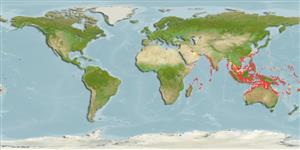>
Ovalentaria/misc (Various families in series Ovalentaria) >
Pomacentridae (Damselfishes) > Pomacentrinae
Etymology: Amphiprion: Greek, amphi = on both sides + Greek, prion, -onos = saw (Ref. 45335).
Eponymy: John Clark was an engraver who engraved plates for JW Bennett and aquatinted the results to produce superb illustrations. [...] (Ref. 128868), visit book page.
Environment: milieu / climate zone / depth range / distribution range
بوم شناسي
دريايي وابسته به آب سنگ; غير مهاجر; تغييرات عمق 1 - 70 m (Ref. 58652). Tropical; 30°N - 30°S, 47°E - 172°W
Indo-West Pacific: Persian Gulf to Western Australia, throughout the Indo-Australian Archipelago and in the western Pacific at the islands of Melanesia and Micronesia, north to Taiwan, southern Japan and the Ryukyu Islands.
Size / Weight / سن
Maturity: Lm ? range ? - ? cm
Max length : 15.0 cm SL جنس نر / بدون خواص جنسي; (Ref. 6113); بيشينه سن گزارش شده: 11 سال ها (Ref. 11318)
خارهاي باله پشتي (کل) : 10; شعاع نرم باله پشتي (کل) : 15 - 16; خارهاي باله مخرجي: 2; شعاع نرم باله مخرجي: 13 - 14.
Adults inhabit lagoons and outer reef slopes. Omnivorous. Oviparous, with elliptical eggs (Ref. 240). Monogamous (Ref. 52884). Oviparous, distinct pairing during breeding (Ref. 205). Eggs are demersal and adhere to the substrate (Ref. 205). Males guard and aerate the eggs (Ref. 205). Associated with the anemones: Cryptodendrum adhaesivum, Entacmaea quadricolor, Heteractis aurora, Heteractis crispa, Heteractis magnifica, Heteractis malu, Macrodactyla doreensis, Stichodactyla gigantea, Stichodactyla haddoni, and Stichodactyla mertensii(Ref. 5911). Has been observed to share home anemone with individuals of A. sandaracinos (Ref. 90000). Has been reared in captivity (Ref. 35418, 35420). Maximum depth reported taken from Ref. 128797.
Benthic spawner. Sex reversal is completed in less than 5-6 months (Ref. 34185). Oviparous, distinct pairing during breeding (Ref. 205). Monogamous mating is observed as both obligate and social (Ref. 52884). Eggs are demersal and adhere to the substrate (Ref. 205). Males guard and aerate the eggs (Ref. 205).
Allen, G.R., 1991. Damselfishes of the world. Mergus Publishers, Melle, Germany. 271 p. (Ref. 7247)
وضعيت در فهرست قرمز IUCN (Ref. 130435: Version 2024-1)
خطر برای انسان ها
Harmless
استفاده انسانی
ماهي گيري – شيلات: معاش ماهیگیری; آكواريوم: تجاري
ابزارها
گزارش های ويژه
بارگيری XML
منابع اينترنتي
Estimates based on models
Preferred temperature (Ref.
123201): 25.3 - 29, mean 27.9 °C (based on 742 cells).
Phylogenetic diversity index (Ref.
82804): PD
50 = 0.5000 [Uniqueness, from 0.5 = low to 2.0 = high].
Bayesian length-weight: a=0.02344 (0.01134 - 0.04848), b=2.98 (2.80 - 3.16), in cm total length, based on LWR estimates for this (Sub)family-body shape (Ref.
93245).
Trophic level (Ref.
69278): 2.9 ±0.1 se; based on diet studies.
Generation time: 2.7 ( na - na) years. Estimated as median ln(3)/K based on 1
growth studies.
جهندگی (Ref.
120179): متوسط, كمينه زمان لازم براي دو برابر شدن جمعيت 4/1 – 4/4 سال (Fec = 1,000).
Fishing Vulnerability (Ref.
59153): Low to moderate vulnerability (29 of 100).
Nutrients (Ref.
124155): Calcium = 81.5 [41.5, 125.4] mg/100g; Iron = 0.659 [0.409, 1.063] mg/100g; Protein = 18.2 [17.1, 19.4] %; Omega3 = 0.118 [0.074, 0.185] g/100g; Selenium = 28.5 [16.5, 51.2] μg/100g; VitaminA = 85.3 [24.3, 288.6] μg/100g; Zinc = 1.51 [1.06, 2.15] mg/100g (wet weight);
